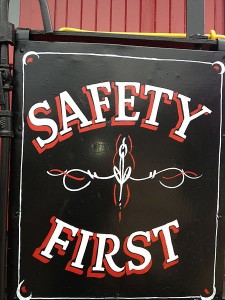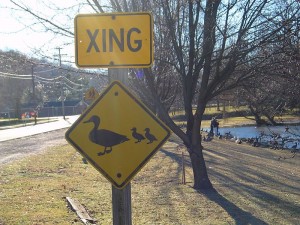Think twice before braking (or speeding) for animals

Should this be the guiding rule for the animal/human trade-off? Image: Creative Commons from ТимофейЛееСуда
Here’s a small news item from this week in which a Quebec couple got a speeding ticket for $258 while rushing their unconscious dog to a veterinarian.
According to the CBC, pet owner Francine Monette complained, “There was no compassion, no hesitation, no nothing. [The officer] was like ice. He could have given us a warning.” The same article details that after making the traffic stop, Laval Police Constable Franco Di Genova did escort the car to the veterinarian’s office, where the pet chihuahua, Mister Albert, died.
The Ottawa Sun reports the Laval Police Department says the officer responded properly:
“The couple was more than 35 km/h over the limit,” said Lieut. Daniel Guerin. “We have a lot of empathy for the lady and her dog, but citizens cannot make ambulance runs, especially when they’re emotionally involved.”
Guerin added that Monette and her husband were stopped on a highway that has the highest collision rate in Quebec.
This incident concerns a pet that may have died in any case and a dispute about a speeding fine. But it reminded me of a far more serious car/animal incident, also from Quebec.
As recounted by this 7/16 commentary from the National Post:
The fatal collision occurred on June 27, 2010, when [Emma] Czornobaj stopped her Honda Civic in the passing lane on Highway 30 in Candiac, south of Montreal. Czornobaj, now 25, told police at the time that she had pulled over, turned on her hazard lights and exited the car to help a family of ducks out of harm’s way on the highway (witnesses later testified that Czornobaj’s hazard lights were not on). Moments later, André Roy, 50, driving a Harley-Davidson motorcycle carrying his daughter, Jessie, 16, slammed into the back of Czornobaj’s parked vehicle. Both Roy and his daughter were killed.
However well-intended Czornobaj’s action may have been, she was tried and convicted of criminal negligence causing death and dangerous operation of a motor vehicle. The maximum sentence for those charges could be as severe as life in prison, though that seems unlikely. Sentencing that had been set for August was delayed until September. An on-line petition that opposes jail time in this case has drawn well over 17,000 signatures to date.
In another situation involving animal rescue, this August a pet owner in Ottawa died after re-entering a burning townhouse complex hoping to save her (blind) pet Dalmatian.
Very likely many readers would either respect the selflessness of going back for a pet, or do the same themselves. But surely it’s one thing to risk your own life over that choice, and something else again to risk the lives of other drivers, or endanger first responders who may have to try to rescue the recuser.
In this CBC interview from July 16, Czornobaj said “It was just a reaction to what was on the road. You know, some people – which really hurts me – say ‘Oh, she chose between human lives and duck lives’ and that’s not what happened.’ “And yet two people died. It does suggest one must think carefully about their response to road situations.
On a broader level, there’s a variety of advice about how to handle animal encounters while driving. Keep in mind the peak danger for hitting animals like deer tends to be the soon-to-be-upon us season of Oct-Dec.
Although the examples discussed in this post are far from identical, where would you draw lines about how much should be risked to save animals?

Few want to hit animals while driving, but that’s not the whole story when it comes to road safety. Image: Creative Commons, uploaded by AlbertHerring
Tags: canada, Emma Czornobaj, fire, Ontario, Pets, Quebec, risk, safety, traffic accidents








Update on the Emma Czornobaj case:
The Montréal Gazette reports that on Friday the prosecution asked for a prison sentence of 9 months and 240 hours of community service. Czornobaj’s attorney is comfortable withe the community service proposed but believes his client should be spared jail time. Final sentencing is expected to come in December.